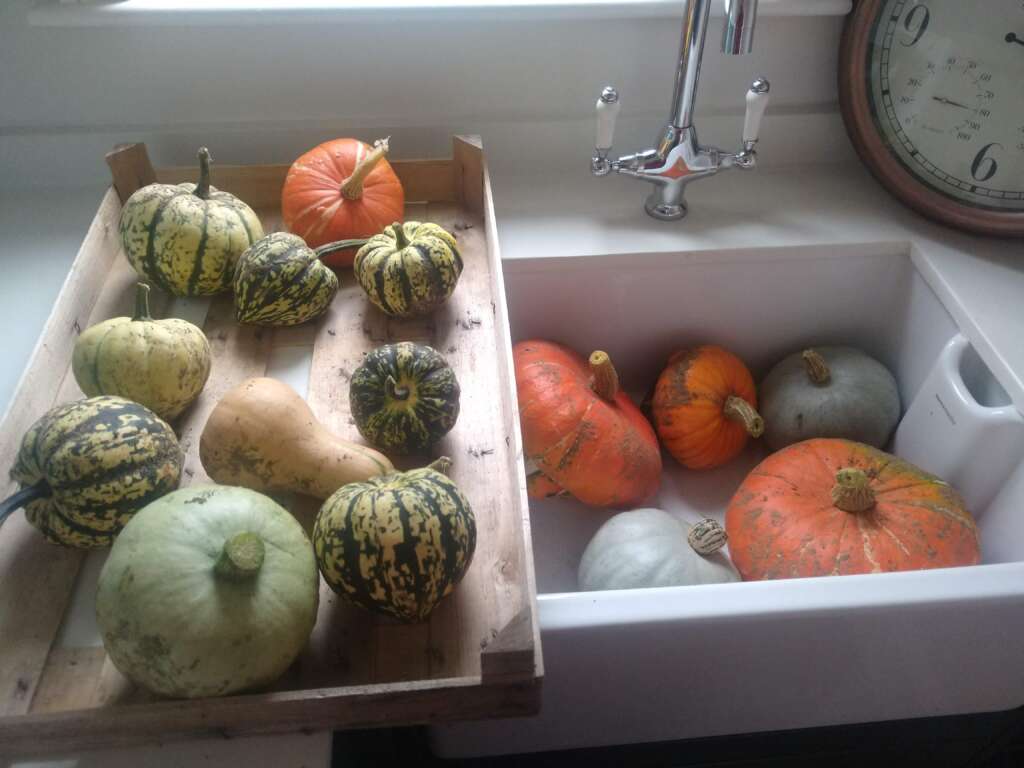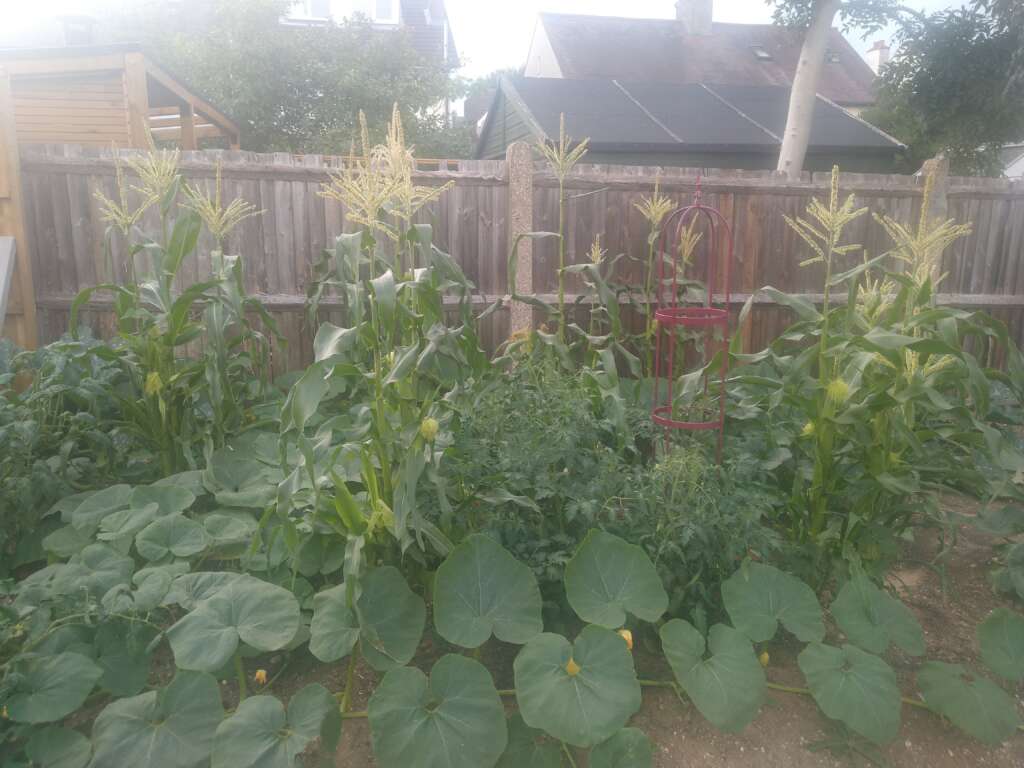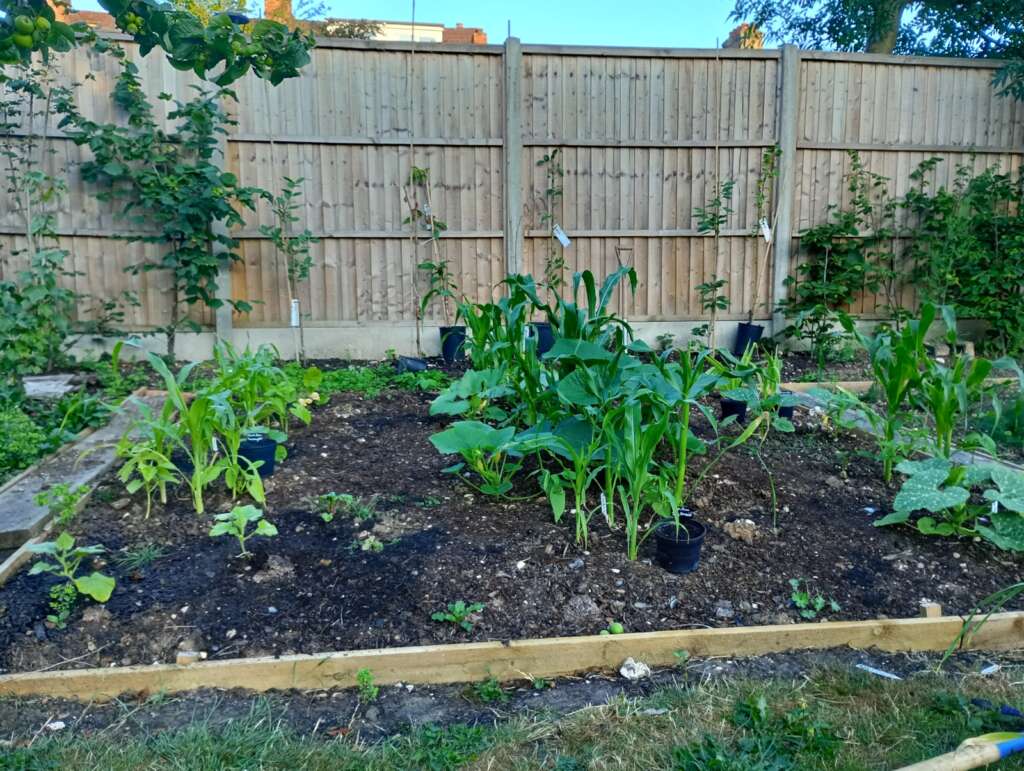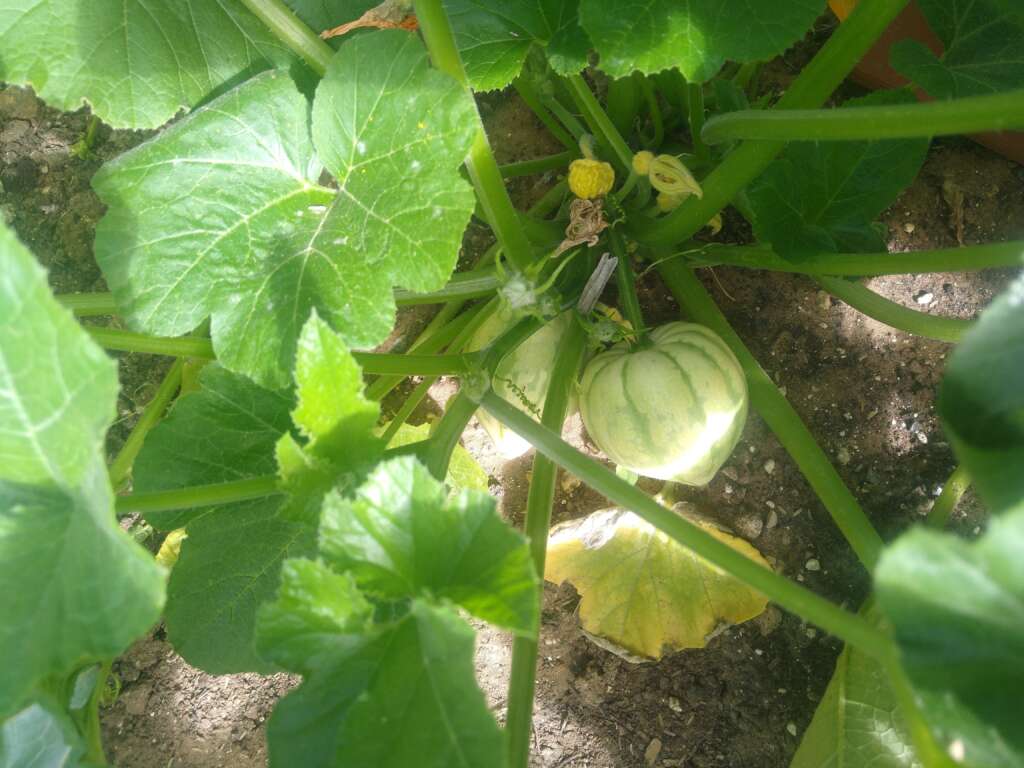
Have you heard of the Three Sisters garden? Until 2020, I hadn’t either, but now I wouldn’t be without it in my vegetable garden. Keep reading to find out what it is, and how to grow a Three Sisters garden yourself.
It’s an ancient form of companion planting, practised by Native Americans to grow their staple crops: corn, beans and pumpkins/winter squash.
Although I’m lucky to have a large garden, the space given over entirely to vegetable growing is too small to practise the traditional allotment growing techniques used here in the UK and generate a meaningful quantity and variety of food for my family.
Planting a Three Sisters garden was something of a revelation when I stumbled upon it in March 2020, just as we had entered lockdown and been forbidden to leave the house for most of the day. The weather smiled upon us at that worrying and uncertain time and, having only been in our house for a year, in the middle of major renovations, and a garden that had a lot of much needed work leaving it something of a love-starved blank canvas, I set to work.
Prior to moving to our home, we had had a small terraced cottage with a little front and back garden, and around the corner, less than a two minute walk, we had taken on a tiny allotment plot. We crammed all we could into the gardens and the plot, and I had great success with a little block of sweetcorn and a few rampant squash plants but my vegetable growing efforts were sporadic: my enthusiasm great and my knowledge little.
Once we moved into our new home, with all the promise the garden had to offer, we gave up the allotment and started growing fruit and vegetable in any space that we could clear, while we gradually planned out the permanent garden.
And so, in March 2020, while ordering seeds to grow I stumbled across the Three Sisters method. When I put away a dozen or more winter squash to store, and we harvested the sweetest freshest corn, and handfuls of crunchy beans, I was a convert.


The two photos above show a pretty similar position in the garden. Our 2020 temporary vegetable patch has now become our permanent kitchen garden, and this bed works really well for growing corn, beans and squash, getting sun for much of the day but only casting shade over it’s neighbouring bed, the asparagus and strawberry patch, in late summer/early autumn when the strawberries and asparagus are already well finished for the year.
How Does a Three Sisters Garden Work?
The idea of a Three Sisters garden is that each of the vegetables gives and takes, allowing each of the others to grow equally strongly. The sweetcorn, which is planted first, acts as a support for the climbing beans. The beans fix nitrogen at their roots, which provides a nutrient rich environment for the corn and the pumpkins or squash, and the squash vines provide ground cover, keeping down weeds and shading the ground to preserve moisture.
Importantly, the corn is planted in blocks, which aids pollination. The smallest recommended space for a three sisters garden is 3 m x 3 m, however I have successfully grown corn in smaller spaces, so you may still wish to try. Although it seems like a lot of space, the corn does not get planted until June, and the bed will be empty again by mid October, so there is plenty of opportunity to use the space to overwinter other vegetables, or plant quick growing early crops like chard and salads – this year I had a good harvest of chard, spinach, beetroot and radishes before clearing the bed for the corn.
In the space you will be able to grow 28 sweetcorn plants, 28 bean plants and 16 squash or pumpkin vines, which even with average yields is a significant amount of produce for fresh eating, storing or preserving.
What Varieties to Choose?
The Three Sisters method comes originally from North America, where the varieties grown would have been those mainly for drying and storing, in much hotter temperatures (despite the heat we’ve had in much of the UK for the past few summer!)
I don’t have much use for dried corn, although in another part of the garden I am growing glass gem corn for decoration and for popcorn, so I prefer to grow sweetcorn. This year, I’m growing a variety called Special Swiss. I’ve not grown it before, but the germination from the seed was excellent, and so far the plants are looking healthy and strong.
I’m terrible for choosing lots of varieties to grow, I can never choose just one or two! For that reason, I’m growing five kinds of climbing bean this year: Lazy Housewife (french bean); Celebration (a runner bean with beautiful peach coloured flowers); Cherokee Trail of Tears (a bean originating from Cherokee Native Americans); Neckargold (a yellow french bean); and Greek Gigantes (an enormous runner bean, grown for its pods, which can be eaten fresh or dried and cooked, as in the famous Greek dish).

As for the pumpkins and squashes, I love to display them in my autumn/fall decor as well as cooking with them, and so growing different forms with varying textures is important to me. This year I’m growing: Queensland Blue; Waltham Butternut; Thelma Sanders’ Sweet Potato; Burgess Buttercup; North Georgia Candy Roaster (doesn’t that just sound so beautiful!); New England Pie; and Victor. I’m also growing Jack-be-Little and Casperita mini pumpkins elsewhere in the garden for my daughter – worth a try if you haven’t much space as these are easy to grow as climbers with small fruit that shouldn’t need additional support.

How to Grow a Three Sisters Garden
If you’re in the UK, it’s too late to sow these vegetables from seed now, with the possible exception of the beans, however you may still be able to buy young plants from a garden centre to start you off.
You need a space, approximately 3 m x 3 m in which to plant your Three Sisters, this is to ensure adequate pollination of the corn. If you don’t have this much space to spare, it’s still worth trying, or you could think about growing your climbing beans up more traditional wigwams, with the squash plants growing around them.
Mark three rows, equally spaced, through the plot, and mark five equally spaced circles or mounds in each row. In the outer rows, you are going to plant four sweetcorn plants in a square in mounds 2 and 4, in the middle row, you will plant four sweetcorn plants in mounds 1, 3 and 5. The sweetcorn in each mound should be about 6 inches apart. Once your sweetcorn has reached around 12 inches high, it’s time to sow your beans. This is to give adequate height to support the beans so they don’t collapse or overwhelm the sweetcorn.
Your beans will be planted in the gaps between your sweetcorn plants. I prefer to sow them in pots and then plant out, but you can sow the beans direct if you prefer.
I like to sow my squashes and pumpkins at the same time as my sweetcorn, and then plant them out together. You are going to plant two pumpkin or squash plants in each of the empty mounds (in between the sweetcorn and bean mounds).
Once you have planted out your Three Sisters garden, I advise keeping any weeds down until the pumpkins have begun to provide good ground cover. Initially you may also need to encourage your beans to climb the sweetcorn by winding them through the leaves or around the stems. Apart from that, all you need to do is water! You may wish to feed your squash/pumpkins (they are hungry plants!) but if you’ve mulched your bed or are practising no dig (as I am) you may not think it’s necessary.

I’d love to hear from you if you decide to give the Three Sisters garden a try, or even any of the vegetables mentioned, they really are so versatile. If you grow flint corn, such as the glass gem corn, you can even use these and the pumpkins in your autumn/fall home decor. If you’d like to hear from me, please subscribe to get my latest posts on gardening, cooking and lifestyle ideas straight to your inbox.
This post contains affiliate links. If you purchase something through an affiliate link, I may be paid, but you will not be charged more. I only recommend products I have used or would use and will always give my honest opinion.
An interesting post, I don’t know anyone who’s tried it and it only gets a mention in the forums, etc. occasionally. xx
I’m hoping for a good result again this year. The weather this week is better for it, wetter but still warm and sunny. X